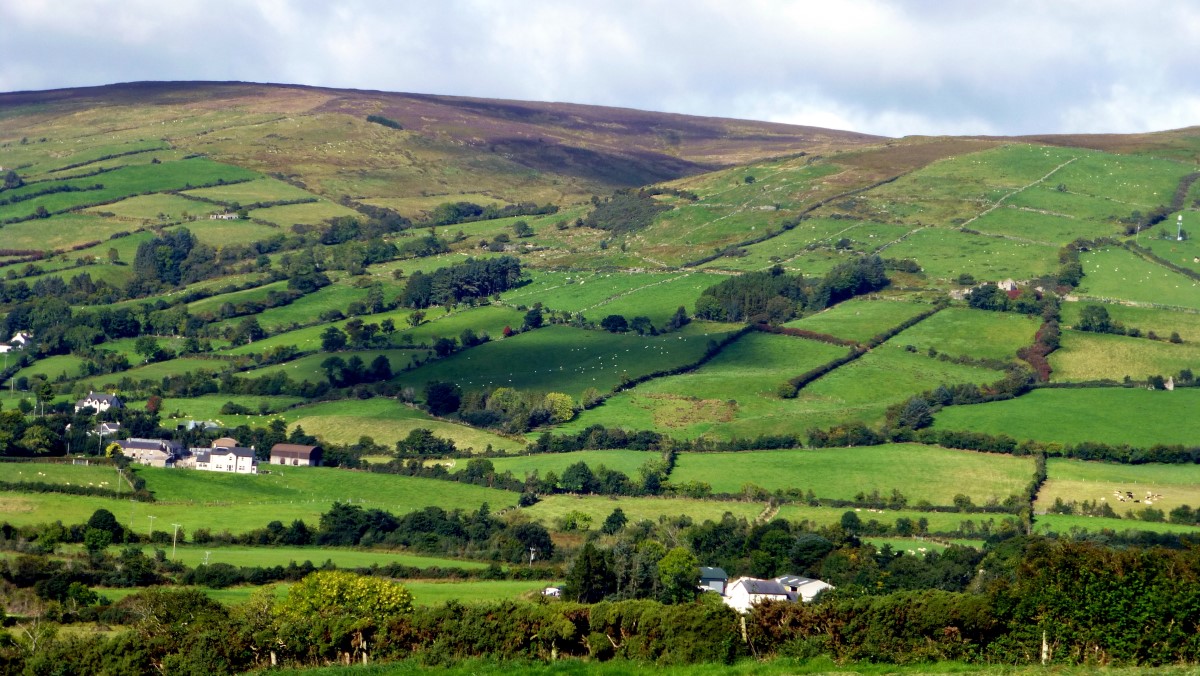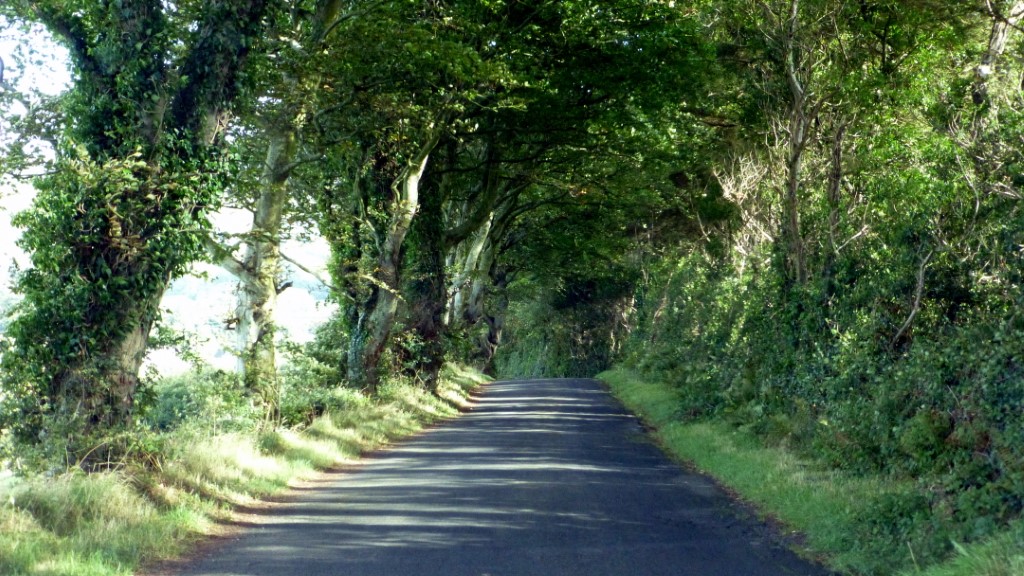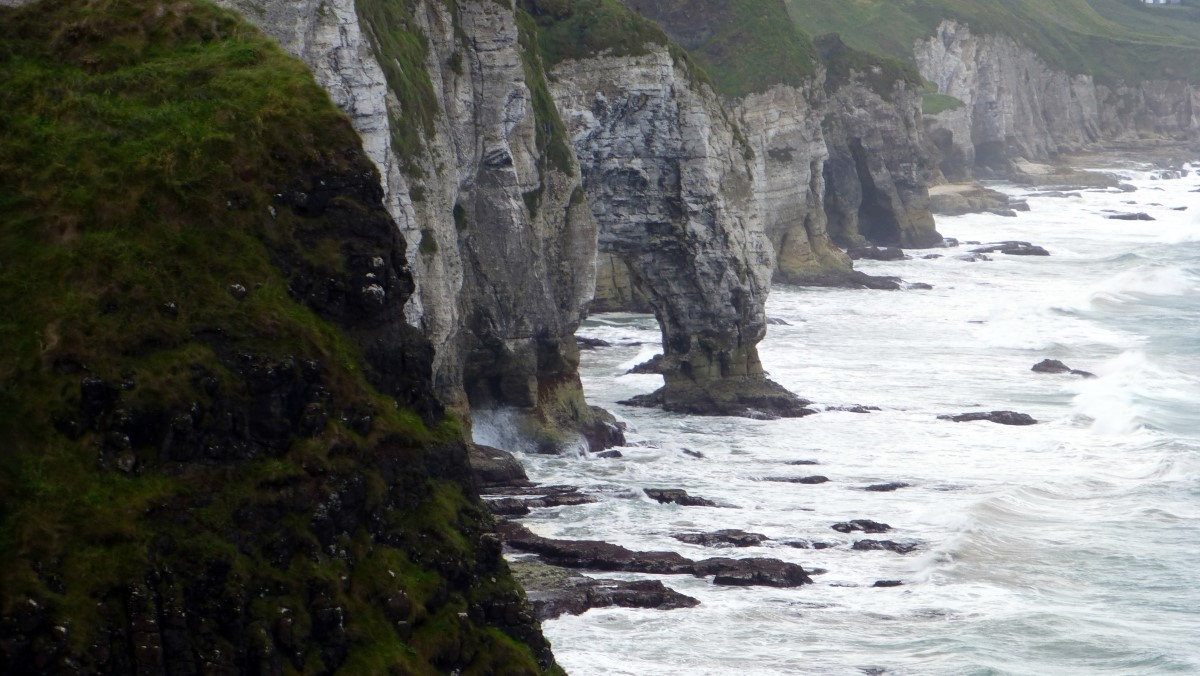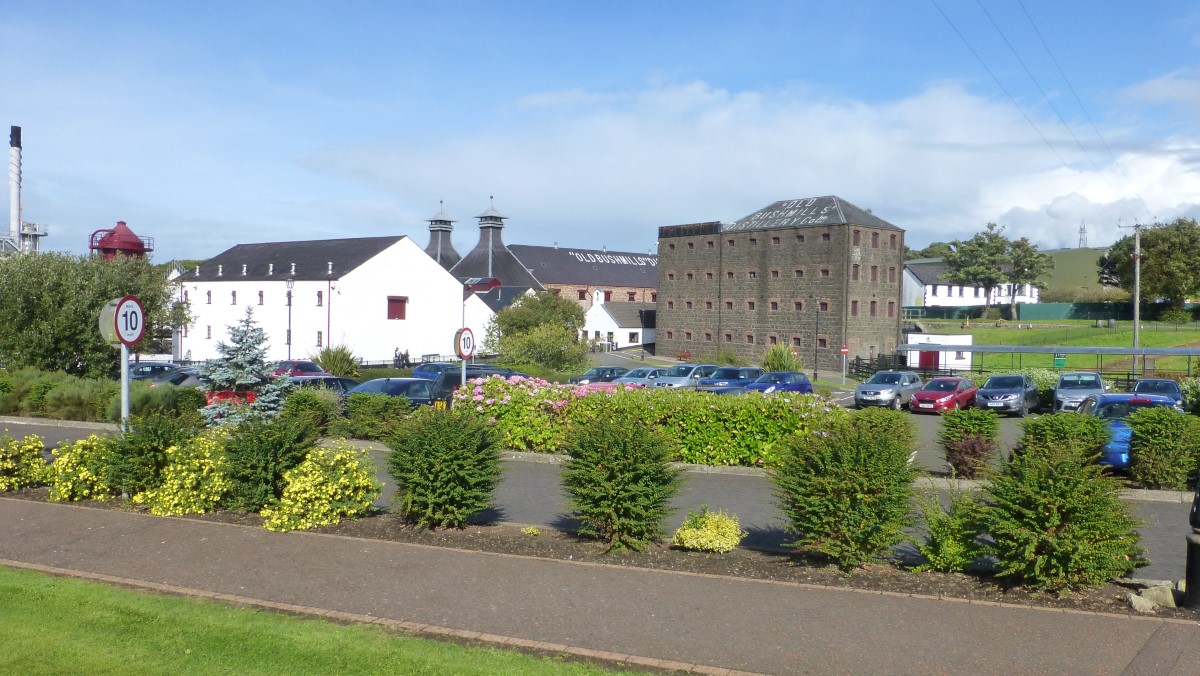
This day dawned with much more blue than white in the sky portending another lovely Irish day. Our first stop was for breakfast. Unfortunately, we have to wait till 9am for it to open. Oddly, finding breakfast here has been quite the chore. It appears that it is not as important to the Irish as to us Americans. We had to ask at Mattie's at dinner to find anything. ( Mattie's does not server breakfast.) And even the luncheon establishments don't open till 11:30 or noon. Our waiter suggest the Glenarm Castle Gardens Tea Room which is on our way to the day’s itinerary..
Mattie's does not server breakfast.) And even the luncheon establishments don't open till 11:30 or noon. Our waiter suggest the Glenarm Castle Gardens Tea Room which is on our way to the day’s itinerary..
Today we head to the Giant's Causeway, a place that has intrigued me since I was but a wee lad. While it is the result of volcanic magma flow and hexagonal crystallization, it's true origin is cloaked in Irish lore.
The story goes that the Irish giant Finn MacCool (Fionn mac Cumhaill), from the Fenian Cycle of Gaelic mythology, was challenged to a fight by the Scottish giant Benandonner. Finn accepted the challenge and built the Causeway across the North Atlantic to get at the Scottish giant. Now, stories differ as to how the meeting of the giants came out. In one, Finn, much the larger of the two giants, easily defeated the Scot. In the other, Benandonner, seeing the size of Finn, retreats to his home where his wife disguises him as a wee babe. Seeing the babe, Finn could only imagine the size of his father and so retreats back to Ireland, destroying the causeway as he goes. Were I an Irishman, I'd go with the story number one.
Geologists, not accepting the simple explanation above, say that the Causeway was created 50 to 60 million years ago during the Paleocene Epoch. However created, what remains is about 40,000 crystallized interlocking basalt columns. I can't verify that number, I lost count at about 50. Today the Causeway is a World Heritage Site and attracts over one million tourists a year.
50. Today the Causeway is a World Heritage Site and attracts over one million tourists a year.
Just down the road from the Causeway, lying on the edge of a basalt outcropping above the North Sea, is the ruins of Dunluce Castle. The original castle was built in the 13th century by Richard Óg de Burgh, 2nd Earl of Ulster. Later Dunluce Castle became the home of the chief of the Clan MacDonnell of Antrim and then Clan MacDonald of Dunnyveg of Scotland. Dunluce Castle served as the seat of the Earl of Antrim until the impoverishment of the MacDonnells in 1690, following the Battle of the Boyne. Since that time, the castle has deteriorated and parts were scavenged to serve as materials for nearby buildings.
Our next stop would prove to be less for the mind and more for the body. The Old Bushmills Distillery lies in Bushmills, County Antrim. First licensed by King James I of England in 1608, it has gone by Bushmills since it was established in 1784 by Hugh Anderson. Here, Irish single malt whiskey is distilled. There is a difference in Irish and Scottish whiskey. First they stop the malting process of the barley with pure heat rather than peat fires (which results in the peaty, smokey flavor of Scotch). And second, they distill the alcohol not twice but three times which, according to the Irish, makes for a smoother whiskey. At the end of our tour, as the driver, I could only take a small taste of the final product. I did choose the 25 year old Black Bush which sells for £159 per bottle. Quite smooth but not sure I'm ready to give up my Lagavulin!
 Our last destination of the day was Gracehill House & the Dark Hedges. Gracehill was built by James Stuart (related? possibly) in 1775 and named it after his wife, Grace Lynd. We did not have time to actually go into the house; however, we did drive down what is known as the Dark Hedges. The hedges is made up of old beech trees that grow over the road from both sides creating a tunnel of sorts. It is said to be the haunt of the Grey Lady, a spectre that walks the Hedges on some nights. Some say she is the daughter of James Stuart known as "Cross Peggy". The Hedges was used in a scene in season 2 of Game of Thrones with Arya Stark, Yoren, Gendry and Hot Pie travelling along the Kings Road to the Wall. For you GOT fans, much of the series was filmed here in Northern Ireland and we find references to the show just about everywhere we go.
Our last destination of the day was Gracehill House & the Dark Hedges. Gracehill was built by James Stuart (related? possibly) in 1775 and named it after his wife, Grace Lynd. We did not have time to actually go into the house; however, we did drive down what is known as the Dark Hedges. The hedges is made up of old beech trees that grow over the road from both sides creating a tunnel of sorts. It is said to be the haunt of the Grey Lady, a spectre that walks the Hedges on some nights. Some say she is the daughter of James Stuart known as "Cross Peggy". The Hedges was used in a scene in season 2 of Game of Thrones with Arya Stark, Yoren, Gendry and Hot Pie travelling along the Kings Road to the Wall. For you GOT fans, much of the series was filmed here in Northern Ireland and we find references to the show just about everywhere we go.
Returning to the Cottage, Our Lady routed us over some very narrow and seldom used roads. We passed over a range of hills with heather spread as far as we could see. It reminded me of my first trip to Scotland and the bit of Heaven I found in the fields of heather in the Cairngorm Mountains. Unfortunately, we must be in the waning season of their flowering as I saw very few in bloom.
For dinner, I had a light fare as I had eaten a large bowl of Irish stew for lunch. However, I did partake of the Guinness and topped it off with a coffee and Baileys.















Today we head to the Giant's Causeway, a place that has intrigued me since I was but a wee lad. While it is the result of volcanic magma flow and hexagonal crystallization, it's true origin is cloaked in Irish lore.
The story goes that the Irish giant Finn MacCool (Fionn mac Cumhaill), from the Fenian Cycle of Gaelic mythology, was challenged to a fight by the Scottish giant Benandonner. Finn accepted the challenge and built the Causeway across the North Atlantic to get at the Scottish giant. Now, stories differ as to how the meeting of the giants came out. In one, Finn, much the larger of the two giants, easily defeated the Scot. In the other, Benandonner, seeing the size of Finn, retreats to his home where his wife disguises him as a wee babe. Seeing the babe, Finn could only imagine the size of his father and so retreats back to Ireland, destroying the causeway as he goes. Were I an Irishman, I'd go with the story number one.
Geologists, not accepting the simple explanation above, say that the Causeway was created 50 to 60 million years ago during the Paleocene Epoch. However created, what remains is about 40,000 crystallized interlocking basalt columns. I can't verify that number, I lost count at about
Just down the road from the Causeway, lying on the edge of a basalt outcropping above the North Sea, is the ruins of Dunluce Castle. The original castle was built in the 13th century by Richard Óg de Burgh, 2nd Earl of Ulster. Later Dunluce Castle became the home of the chief of the Clan MacDonnell of Antrim and then Clan MacDonald of Dunnyveg of Scotland. Dunluce Castle served as the seat of the Earl of Antrim until the impoverishment of the MacDonnells in 1690, following the Battle of the Boyne. Since that time, the castle has deteriorated and parts were scavenged to serve as materials for nearby buildings.
Our next stop would prove to be less for the mind and more for the body. The Old Bushmills Distillery lies in Bushmills, County Antrim. First licensed by King James I of England in 1608, it has gone by Bushmills since it was established in 1784 by Hugh Anderson. Here, Irish single malt whiskey is distilled. There is a difference in Irish and Scottish whiskey. First they stop the malting process of the barley with pure heat rather than peat fires (which results in the peaty, smokey flavor of Scotch). And second, they distill the alcohol not twice but three times which, according to the Irish, makes for a smoother whiskey. At the end of our tour, as the driver, I could only take a small taste of the final product. I did choose the 25 year old Black Bush which sells for £159 per bottle. Quite smooth but not sure I'm ready to give up my Lagavulin!
Returning to the Cottage, Our Lady routed us over some very narrow and seldom used roads. We passed over a range of hills with heather spread as far as we could see. It reminded me of my first trip to Scotland and the bit of Heaven I found in the fields of heather in the Cairngorm Mountains. Unfortunately, we must be in the waning season of their flowering as I saw very few in bloom.
For dinner, I had a light fare as I had eaten a large bowl of Irish stew for lunch. However, I did partake of the Guinness and topped it off with a coffee and Baileys.
